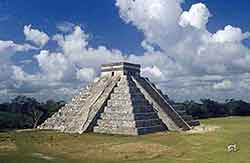Land of the Maya
Chichén Itzá


The Maya name Chichén Itzá means "At the mouth of the well of the people". Although this was the usual name for the site in Pre-Columbian times, it is also referred to in the ancient chronicles as "Uucyabnal," meaning "Seven Great Rulers".
About AD 987 a Toltec king named Quetzalcoatl / Kukulkan ( the Feathered Serpent God) arrived here with an army from central Mexico and with local Maya allies made Chichén Itzá his capital.
Recently named one of the New 7 Wonders of the World, The Temple of Quetzalcoatl / Kukulkan dominates the center of Chichén Itzá. The Temple, often referred to as "El Castillo", is he largest and most important ceremonial structure at Chichén Itzá. This ninety-foot tall pyramid is precisely oriented to mark the solstices and equinoxes. The axes that run through the northwest and southwest corners of the pyramid are oriented toward the rising point of the sun at the summer solstice and its setting point at the winter solstice.

At sunset on the Spring and Autumn equinoxes, an interplay between the sun's light and the edges of the stepped terraces on the pyramid creates a fascinating ; shadow display upon the sides of the northern stairway. A serrated line of seven interlocking triangles gives the impression of a long tail leading downward to the stone head of the serpent Kukulkan, at the base of the stairway.
Each face of the four-sided structure has a stairway with ninety-one steps, which together with the shared step of the platform at the top, add up to 365, the number of days in a year. These stairways also divide the nine terraces of each side of the pyramid into eighteen segments, representing the eighteen months of the Mayan calendar. The northern stairway was the principal sacred path leading to the summit. Adjacent to the head of Kukulkan, a doorway leads to an interior staircase ending at a small and very mysterious shrine.
The Maya chronicles record that in 1221 a revolt and civil war broke out, and archeological evidence confirms that the wooden roofs of the great market and the Temple of the Warriors were burnt at about this date. Chichén Itzá went into decline as control over Yucatán shifted to Mayapan. While the site was never completely abandoned, the population declined and no major new constructions were built. The Sacred Cenote, however, remained a place of pilgrimage.
